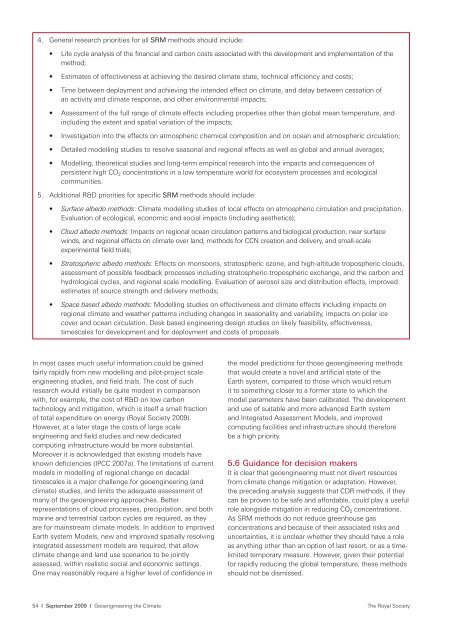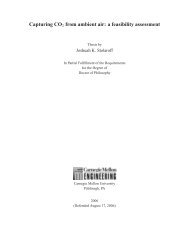Royal Society - David Keith
Royal Society - David Keith
Royal Society - David Keith
You also want an ePaper? Increase the reach of your titles
YUMPU automatically turns print PDFs into web optimized ePapers that Google loves.
4. General research priorities for all SRM methods should include:<br />
• Life cycle analysis of the financial and carbon costs associated with the development and implementation of the<br />
method;<br />
• Estimates of effectiveness at achieving the desired climate state, technical efficiency and costs;<br />
• Time between deployment and achieving the intended effect on climate, and delay between cessation of<br />
an activity and climate response, and other environmental impacts;<br />
• Assessment of the full range of climate effects including properties other than global mean temperature, and<br />
including the extent and spatial variation of the impacts;<br />
• Investigation into the effects on atmospheric chemical composition and on ocean and atmospheric circulation;<br />
• Detailed modelling studies to resolve seasonal and regional effects as well as global and annual averages;<br />
• Modelling, theoretical studies and long-term empirical research into the impacts and consequences of<br />
persistent high CO 2 concentrations in a low temperature world for ecosystem processes and ecological<br />
communities.<br />
5. Additional R&D priorities for specific SRM methods should include:<br />
• Surface albedo methods: Climate modelling studies of local effects on atmospheric circulation and precipitation.<br />
Evaluation of ecological, economic and social impacts (including aesthetics);<br />
• Cloud albedo methods: Impacts on regional ocean circulation patterns and biological production, near surface<br />
winds, and regional effects on climate over land; methods for CCN creation and delivery, and small-scale<br />
experimental field trials;<br />
• Stratospheric albedo methods: Effects on monsoons, stratospheric ozone, and high-altitude tropospheric clouds,<br />
assessment of possible feedback processes including stratospheric-tropospheric exchange, and the carbon and<br />
hydrological cycles, and regional scale modelling. Evaluation of aerosol size and distribution effects, improved<br />
estimates of source strength and delivery methods;<br />
• Space based albedo methods: Modelling studies on effectiveness and climate effects including impacts on<br />
regional climate and weather patterns including changes in seasonality and variability, impacts on polar ice<br />
cover and ocean circulation. Desk based engineering design studies on likely feasibility, effectiveness,<br />
timescales for development and for deployment and costs of proposals.<br />
In most cases much useful information could be gained<br />
fairly rapidly from new modelling and pilot-project scale<br />
engineering studies, and field trials. The cost of such<br />
research would initially be quite modest in comparison<br />
with, for example, the cost of R&D on low carbon<br />
technology and mitigation, which is itself a small fraction<br />
of total expenditure on energy (<strong>Royal</strong> <strong>Society</strong> 2009).<br />
However, at a later stage the costs of large scale<br />
engineering and field studies and new dedicated<br />
computing infrastructure would be more substantial.<br />
Moreover it is acknowledged that existing models have<br />
known deficiencies (IPCC 2007a). The limitations of current<br />
models in modelling of regional change on decadal<br />
timescales is a major challenge for geoengineering (and<br />
climate) studies, and limits the adequate assessment of<br />
many of the geoengineering approaches. Better<br />
representations of cloud processes, precipitation, and both<br />
marine and terrestrial carbon cycles are required, as they<br />
are for mainstream climate models. In addition to improved<br />
Earth system Models, new and improved spatially resolving<br />
integrated assessment models are required, that allow<br />
climate change and land use scenarios to be jointly<br />
assessed, within realistic social and economic settings.<br />
One may reasonably require a higher level of confidence in<br />
the model predictions for those geoengineering methods<br />
that would create a novel and artificial state of the<br />
Earth system, compared to those which would return<br />
it to something closer to a former state to which the<br />
model parameters have been calibrated. The development<br />
and use of suitable and more advanced Earth system<br />
and Integrated Assessment Models, and improved<br />
computing facilities and infrastructure should therefore<br />
be a high priority.<br />
5.6 Guidance for decision makers<br />
It is clear that geoengineering must not divert resources<br />
from climate change mitigation or adaptation. However,<br />
the preceding analysis suggests that CDR methods, if they<br />
can be proven to be safe and affordable, could play a useful<br />
role alongside mitigation in reducing CO 2 concentrations.<br />
As SRM methods do not reduce greenhouse gas<br />
concentrations and because of their associated risks and<br />
uncertainties, it is unclear whether they should have a role<br />
as anything other than an option of last resort, or as a timelimited<br />
temporary measure. However, given their potential<br />
for rapidly reducing the global temperature, these methods<br />
should not be dismissed.<br />
54 I September 2009 I Geoengineering the Climate The <strong>Royal</strong> <strong>Society</strong>








